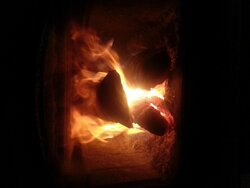
Sorry for the sideways pic. The left is actually the top of the fire box. They are rolling flames sepearated from the wood. There doesn't seem to be any flames actually coming from the tubes? Its dark when I get home so can't Check to see if the chimney Is smoking or not. I can this weekend though. Just trying to decifer a clean burn from a less desirable one from the looks of the fire.
Last edited by a moderator:



